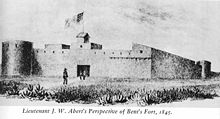Bent's Old Fort National Historic Site
| Bent's Old Fort National Historic Site | ||
|---|---|---|
| In the courtyard of the fort | ||
|
|
||
| Location: | Colorado , United States | |
| Next city: | La Junta | |
| Surface: | 3.2 km² | |
| Founding: | June 3, 1960 | |
| Visitors: | 28,000 (2005) | |
| Location of the fort on the trade routes | ||
Bent's Old Fort National Historic Site is a historic trading post in the southeastern US state of Colorado , on the north bank of the Arkansas River , near today's small town of La Junta. The fort was built in 1833 by William and Charles Bent together with Ceran St. Vrain to provide a permanent seat for the emerging trade with the Cheyenne Indians, as well as the trappers and traders on the Santa Fe Trail .
The current structure is a 1976 reconstruction commissioned by the National Park Service , which manages the memorial.
The construction
The fort is built like a fortress. It consists of an irregular square around a large courtyard with stables and a pen leaning against the northern outer wall. There are massive round towers at two opposite corners. All walls are made of adobe adobe bricks , reinforced with wooden beams.
Inside the fort, in addition to the living quarters of the traders and the sales room, there were also workshops of the most important craftsmen, such as blacksmiths and carpenters, who offered their services to the covered wagon caravans. Although the fort was a private trading post, the US Army stored supplies and ammunition there and used the fort as a base during the Mexican-American War of 1846/48.
history
In 1833 Bent's Old Fort, also known as Bent's Big Lodge, was the only American outpost in the Southwest. All trade with Mexico took place on the Santa Fe Trail , and the fort directly on the Arkansas River, the border river, was for many years the only fixed base on a path of 1300 km and two months, only from 1847 onwards slowly others (military and civil) forts.
Bent's Fort thus had a special role for the merchants in overland trade with Mexico and for the relationship with the Indians and in the colonization of the Wild West . The southern Cheyenne were the immediate neighbors. They first offered beaver and otter furs to the fort's traders , later mostly bison furs, and exchanged tools, (diluted) brandy , glass beads and colorful textiles for them. The post established itself and soon attracted Indians from other regions as well: Arapaho from central Colorado, Comanche , Kiowa and Apaches came from the east and west. Even Ute and Shoshone from the northern Rocky Mountains in what is now Wyoming came to the fort after the fur trade there waned in the mid-1830s.
Eventually, Indians of various peoples began to regard the fort as a neutral place and held their powwows and other negotiations there. The partners Bent and St. Vrain expanded their trading company into an empire. They opened bases in Taos and Santa Fe , as well as agencies in more distant places.
In 1846 the US Army used the fort as a parade ground for the first campaign in the Mexican-American War. Charles Bent was installed as provisional governor in occupied New Mexico in 1846 and slain in a Pueblo Indian revolt the following year . With the peace treaty in 1848, New Mexico , Arizona and California became part of the United States, and the Santa Fe Trail took on a new meaning as a route for thousands of settlers.
The settler treks changed the landscape. The crowds exhausted the springs, cleared the sparse vegetation and shot the bison. As early as 1849, most of the Cheyenne had moved off the trail to the prairies and trade with them collapsed. William Bent tried to sell the fort to the army, but when they were not interested, he gave up. Allegedly, he is said to have blown up the buildings himself, archaeological evidence suggests a fire, the demolition is not detectable. Bent and St. Vrain built a new fort 40 miles (65 km) downstream in 1853.
In the 1870s the railroad came to the Arkansas River, the era of covered wagon trains was over.
Bent's Fort today
In 1960 the fort's location was designated as a National Historic Site and subsequently archaeologically investigated. On December 19, 1960, Bent's Old Fort was recognized as a National Historic Landmark . On October 15, 1966, Bent's Fort was added to the National Register of Historic Places as a Historic District . Drawings made by a Lieutenant Alberts in the 1840s served as additional sources for the reconstruction of the fort with old building materials in 1976.
The fort can be visited, there is a visitor information center with a small museum about the early days of the Wild West and regular tours.
In Fort several movies, including " How the West Was Won (How the West Was Won)" (1962) Director: John Ford Cast: Henry Fonda , Karl Malden , Gregory Peck , George Peppard , James Stewart , John Wayne
literature
- David Dary: The Santa Fe Trail - Its History, Legends, and Lore. Alfred A. Knopf, New York 2001, ISBN 0-375-40361-2 .
- William Y. Chalfant: Dangerous passage - the Santa Fe Trail and the Mexican War. Univ. of Oklahoma Press, Norman, Oklahoma 1994, ISBN 0-8061-2613-2 .
Web links
- National Park Service: Bent's Old Fort National Historic Site (official site; English)
Individual evidence
- ↑ Listing of National Historic Landmarks by State: Colorado. National Park Service , accessed July 20, 2019.
- ^ Bent's Old Fort National Historic Site on the National Register Information System. National Park Service , accessed July 31, 2017.









